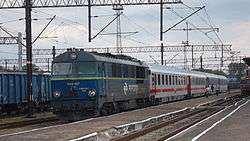Wawel (train)
|
PKP class SU46 with EuroCity "Wawel" ready to leave towards Berlin after change of locomotives at Węgliniec in Poland (May 2012) | |
| Overview | |
|---|---|
| Service type | |
| Status | Discontinued |
| Locale | |
| First service | 1995 |
| Last service | 14 December 2014 |
| Former operator(s) | DB Fernverkehr, PKP Intercity |
| Route | |
| Start | |
| End | |
| Service frequency | Daily |
| Train number(s) |
|
| Technical | |
| Track gauge | 1,435 mm (4 ft 8 1⁄2 in) |
The Wawel was an international named express train. Introduced in 1995 as an InterCity service, it was upgraded to EuroCity status by operating PKP Intercity and DB Fernverkehr in 2006. The service was withdrawn at the end of 2014.
The train linked Kraków and Wrocław in Poland with Berlin and Hamburg in Germany. It was named after the Wawel, the former residence of the Polish kings in Kraków.[1]
Route
Initially, the Wawel ran between Kraków and Berlin, Germany. Trains ran from Kraków Główny railway station via Katowice to Wrocław and used the railway line to Szczecin up to the Rzepin rail hub, from where they ran on the Warsaw–Kunowice railway to the Polish-German border and Frankfurt (Oder). Between Frankfurt and Berlin, the Wawel ran on the Lower Silesian-Marcher Railway line.

In 2001, weekday services were extended from Berlin to Hamburg, while weekend services continued to run only between Kraków and Berlin. Trains then ran via Cottbus, passing the German-Polish border at Forst (Lausitz), and via Żary, Żagań, and Legnica to Wrocław. From 2010, trains ran from Żary via Węgliniec railway station. In December 2012, the eastern section of the route was cut back from Kraków to Wrocław, and in May 2013, the terminus of the western weekday extension was temporarily moved east, to Lüneburg.[1]
The Wawel has never been able to achieve the journey times of those fast diesel multiple unit trains operated by the Deutsche Reichsbahn that ran on the line in the 1930s. Therefore, the number of passengers significantly decreased upon the construction of the parallel A18 and A18 autostradas in Poland. Servives finally discontinued in December 2014.
See also
- History of rail transport in Germany
- History of rail transport in Poland
- List of EuroCity services
- List of named passenger trains of Europe
References
- 1 2 Gardner, Nicky (21 June 2013). "The Wawel tale". Europe by Rail website. hidden europe. Retrieved 1 September 2013. External link in
|website=(help)
External links
-
 Media related to Wawel (train) at Wikimedia Commons
Media related to Wawel (train) at Wikimedia Commons
